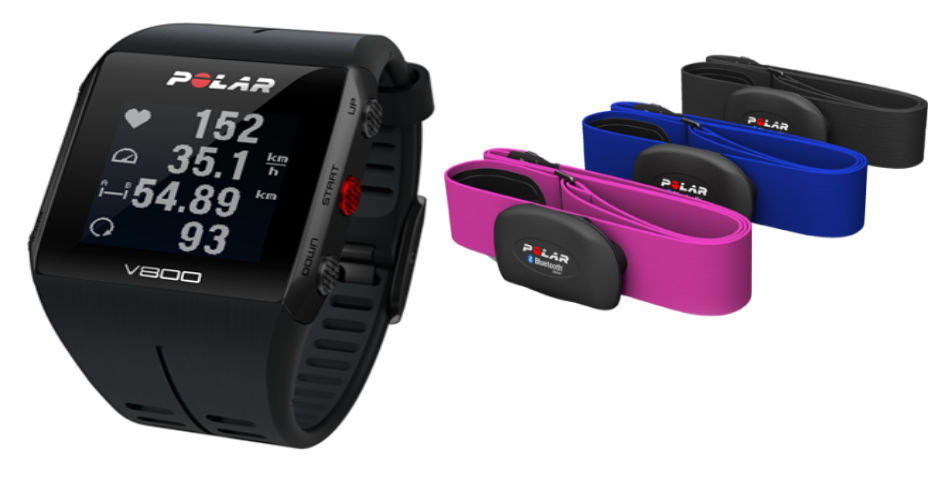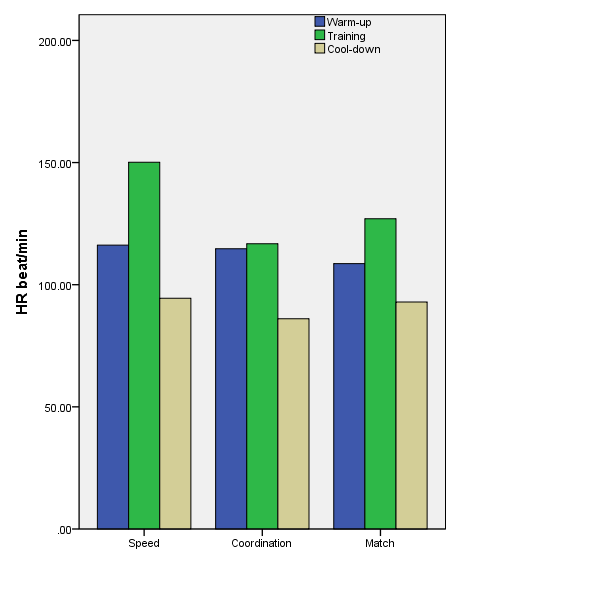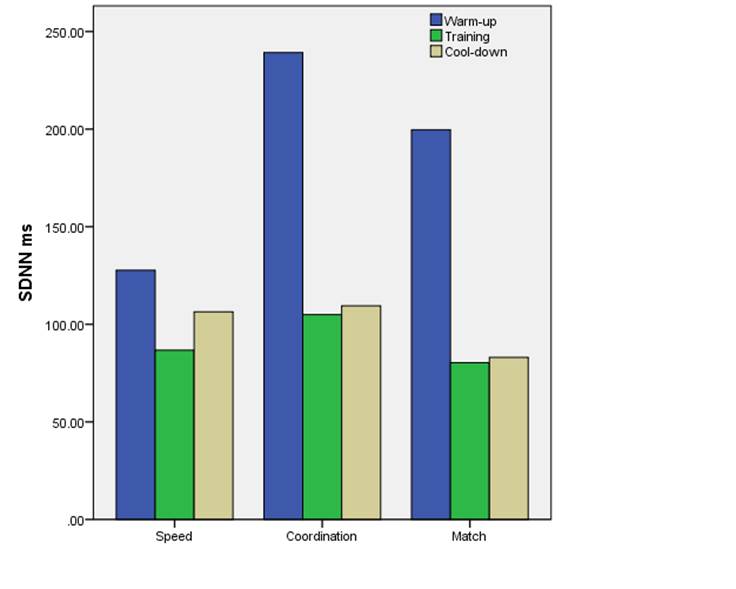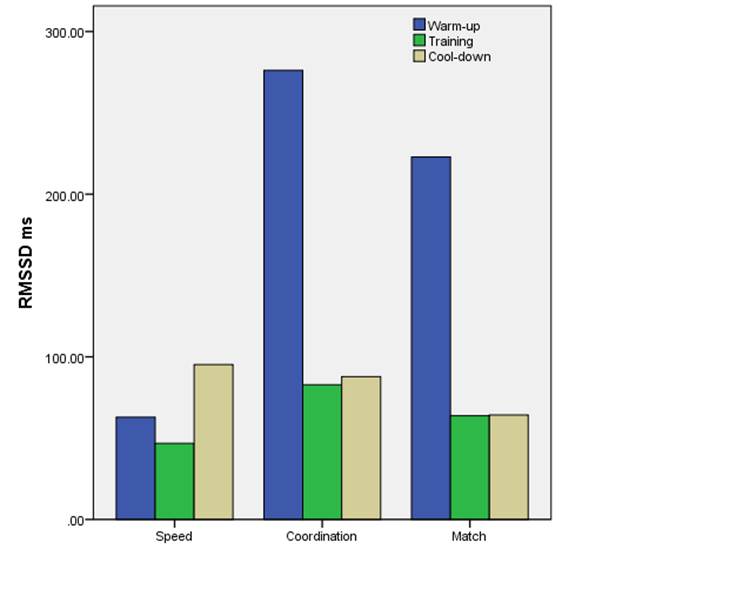Introduction
Today, soccer is being played enormously at its highest level in terms of the human physical capacity. As in other sports, soccer players have to have high-quality training preparation before and during the competition period. Proper preparation allows athletes to reach their highest level of performance, decreases the risk of injury and delay fatigue. Fatigue that can arise from training intensity and load should be minimized as much as possible for those who have been playing soccer at their highest level (Buchheit, Simpson, Al Haddad, Bourdon & Mendez, 2012; Borresen & Lambert, 2008, 2009; Meeusen et al., 2013; Halson, 2014). To understand the relationship between the training load and resting athletes’ cardiovascular system should be objectively monitored by coaches and athletes. The cardiovascular system is the leading body system that determines the intensity of the loading and recovery of the athletes. In particular, the heartbeats are the most crucial factor that determines the intensity of training and recovery of athletes. The assessment of the heart's work during training and matches has gained importance today (Bellenger et al., 2016).
Coaches use several tools/methods to determine the adaptation of their players to the training load. Subjective methods such as surveys and scales and objective methods such as laboratory tests and tracking (global positional system, GPS) are frequently used by coaches (Halson, 2014). Assessment of heart rate variability (HRV) is a relatively new method and increasing the demand for use in sports (Ravé & Fortrat, 2016). Recently, HRV has been used more often to determine the adaptation of training in endurance sports.
HRV is the variation of the intervals between successive hearts beats (R-to-R intervals), which is a standard noninvasive method for assessing the autonomic control on the sinus node. It is a very susceptible and enlightening method to evaluate both physiological and pathologic conditions (Taralov, Terziyski & Kostianev, 2015; Malik et al., 1996). The current technology allows three indices to determine the HRV analysis. Namely, these are: time-domain measures, frequency domain measures, and the non-linear domain measures. HRV variables are easily affected by the depth and frequency of breathing, sleep, emotional state, exercise, and drug use. In professional soccer, researchers emphasized that time-domain variables are least affected by artefacts, less sensitive and less complicated to implement (Naranjo, de la Cruz, Sarabia, de Hoyo & Domínguez, 2015).
In other domains such as endurance type of sports, Bucheit (2014) reported that especially, root mean square of successive RR interval difference (RMSSD) and standard deviation of normal to normal inter-beat interval (SDNN) are more meaningful measures of HRV. These measures affect the parasympathetic portion of the autonomic nervous system. Thus, RMSSD and SDNN are associated with a performance by determining the workload and fatigue of the athlete (Buchheit, 2014; Vesterinen et al., 2013; Plews, Laursen, Stanley, Kilding & Buchheit, 2013; Atlaoui et al., 2007). The SDNN reflects all activity of the autonomic nervous system, whereas RMSSD is associated with the peripheral nervous system (Berntson et al., 1997; Malik et al., 1996; Rajendra, Joseph, Kannathal, Lim & Suri, 2006). Heart rate (HR) is one of the most used markers by coaches and scientists in exercise settings not only in a laboratory environment but also in the fields (White & Raven, 2014). HR is affected by the frequency and depth of respiration, the end-partial pressure of CO2 (Berntson, Cacioppo & Quigley, 1993; Hirsch & Bishop, 1981; Tripathi, 2004). Therefore, factors such as load intensity, duration, and type of exercise affect HRV and HR. The activity of the sympathetic nervous system (SNS) increases to withstand fatigue during and after heavy workouts. The metabolic needs of the body are met by increases in sympathetic nervous system (SNS) activity. Then, the parasympathetic nervous system (PNS) is more effective for better recovery (Taralov et al., 2015; Malik et al., 1996; Halson, 2014).
There are a number of studies that have been conducted to investigate the relationship between exercise and cardiac activity (HR, HRV). In the beginning, more common topics were revealed around the effect of exercise on the cardiovascular system and other diseases (El Agaty, Kirmani & Labban, 2017; Taçoy, Açikgöz, Kocaman, Ozdemir & Cengel, 2010; Liao, Carnethon, Evans, Cascio & Heiss, 2002; Schroeder et al., 2003; Lin et al., 2001). Later, the relationship between HRV and sociodemographic characteristics such as age, sex, race, were examined (Bonnemeier et al., 2003; Choi et al., 2006). Moreover, researchers were interested in the effects of factors such as type, frequency, duration and type of exercise in healthy individuals (Kleiger, Stein & Bigger, 2005; Stanley, Peake & Buchheit, 2013; Perkins, Jelinek, Al-Aubaidy & de Jong, 2017; Esco, Flatt & Williford, 2017). More recently, changes in HRV parameters during training and recovery of athletes have begun to be a more critical research topic for researchers (Ravé & Fortrat, 2016; Naranjo et al., 2015; Plews, Laursen, Kilding & Buchheit, 2013, 2014; Proietti et al., 2017). However, in our knowledge, no study examined the acute response of HRV variables during training in young soccer players during different type of training and recovery period.
Therefore, the main objective of the present study was to determine the time-domains heart rate variability (e.g., SDNN, RMSSD) and heart rate of young soccer players in different work-outs. The second aim was to compare SDNN, RMSSD and HR differences between warm-up, main workout, and cool-down. We hypothesized that there would be a significant difference between SDNN, RMSSD, and HR according to workouts types and within parts of each work-out of young soccer players.
Method
Participants: A total of 15 male soccer players (mean age 15.5 ± 0.5 years, height 171.1 ± 7.9 cm, weight 62.4 ± 8.9 kg, BMI 21.2 ± 1.9 kg/m2) voluntarily participated in the present study. At the time of the experiment, participants had been playing in the U16 team of Bursaspor Club (I Division) at least for three years. Before these players took part in our study, the information obtained that they have not been injured since last six month and previous three months have not used any medications which may have affected their performance. The research was approved by Bursa Uludag University Medical Faculty Ethics Committee (protocol number: 2017-3/24) and conducted in accordance with the Helsinki Declaration. All participants were provided written informed consent before their participation in the current study.
After obtaining permission from the Bursaspor Football Club (FC), participants were informed about the details of research experiments. Then, participants performed three different interventions respectively: (W1) speed work-out, (W2) coordination work-out and (W3) work-out in a match formation. Participants' HRV was measured during warm-up (training T1), main training (training T2) and cool-down (training T3) in each of the three different workouts. Participants’ HR and HRV, were measured by using a Polar V800 heart rate monitor (HRM) with a Polar H7 chest strap at a sampling frequency of 1000Hz. HR and HRV recordings were subsequently stored in the HR monitor and then analyzed using the Polar Flow-Sync Software (Polar) to import into Kubios HRV version 2.2 software (Tarvainen, Niskanen, Lipponen, Ranta-aho & Karjalainen, 2014) for offline analyses.
The interventions were performed on grass field within three separate nonconsecutive days of the week. The soccer work-outs were selected from the current training programs of the week. Researchers were in the measurement area during the measurements, HRV measurements for T1 15 minutes (warm-up), T2 60-70 min (depended on main workout type) and T3 12 minutes (cool-down) lasted. 12 min HRV measurements were made. After the T3 measures were completed, the devices were taken out in order to prevent data confusion and the numbers of the athletes to which they belonged were stored. The obtained data were transferred to the Kubios HRV Analysis program to be displayed on a computer.
Training program. HRV measurements were performed in the following work-outs by the U-16 team.
Speed work-out. The training was started with a warm-up, drills and stretching (15 min). After the warm-up, the main workouts drills were prepared using the agility ladder, slalom, jumping obstacles and training cones. In this course, the training for explosive force, quick shifts and high-intensity sprint runs and dribbling were completed (60 minutes). After the training, the jogging (to cool down) and exercises were performed (12 min).
Coordination work-out. The training was started with the same warm-up procedure (15 min). In the main training phase, coordination courses were carried out, including movements that required environmental control, coordination, balance, and skill. Active rests were done (70 min). After the workout, cooling and recovery were performed including stretching exercises intended.
Match format work-out. The warm-up was performed with straight running, stretching exercises and drills (10 min). Then, participants were divided into two teams. Half-field match training was done. During the training, the game was stopped at intervals, and some tactical moves and changes were made with the guidance of the coach (60 min). At the end of the training, the cooling run and stretching exercises were performed (12 min).
Measurements
Bodyweight and height. Body weight was measured to the nearest kilogram on a digital scale with the participant wearing lightweight clothing and without shoes. Height was measured to the nearest 0.1 cm with a wall-mounted measuring tape. Body mass index was calculated by dividing the weight in kilograms by the height in meters squared (kg/m2).
Heart Rate Variability (HRV). HRV were monitored by Polar V800 monitor (Polar Electro Oy, Kempele, Finland) which monitor is an instantaneous heart rate measurement and imaging system (Giles, Draper & Neil, 2016). Content: Polar H7 transmitter attached to the chest strap, connected to the Polar V800 monitor After data were collected, the researcher transferred the raw data to the Kubios HRV Analysis program, Ver.2.2 (Mindfeld Biosystems Ltd., Gronau, Germany)."Time-domain" option in Kubios HRV Analysis program (Tarveinen et al., 2014) was used to evaluate RMSSD(ms), SDNN(ms) and HR(beat/per min).
Statistical Analysis
The data were analyzed using SPSS 23.0 for Windows (SPSS Corp, Chicago, IL, USA). Descriptive statistics obtained and expressed as mean and standard deviation. Shapiro-Wilk test was used for the verification of data normality. Mauchly’s Test of Sphericity indicated that the assumption of sphericity had not been violated. Baseline (pre-test) descriptive and test scores between the two groups were compared using independent t-test. We conducted a 3 (time) x 3 (intervention) repeated measures of ANOVA for the effectiveness of interventions. Pairwise comparisons of each intervention were applied with Bonferroni corrected posthoc analyses. The Effect Size was also calculated and evaluated with Partial Eta Squared value (ƞ 2 ), which was considered small (.01), medium (.06) and large (.14). Alpha was set at p˂0.05 to achieve statistical significance for all analyses.
Results
Mean, standard deviation, intragroup and intergroup comparisons of HRV time-domain indices and HR values are shown in Table 1. The changes of mean HR, SDNN and RMSSD during different workouts are shown in Figures 2, 3 and 4.
Table 1
Mean standard deviation, intragroup and intergroup comparisons of heart rate variability time domain indices (RMSSD and SDNN) and heart rate values
The multivariate test indicated that there was a significant interaction effect between the time and intervention on RMSSD (Frmat= 2.983) and large effect size (ƞ 2 = .181) and HR (Frmat= 4.894),(ƞ 2 = .266). The univariate test indicated that there was a significant difference between warm-up, main training, and cool-down session for the RMSSD values during match intervention (Frmao= 5.310), while there was no significant difference during coordination and speed interventions. The univariate test indicated that there was a significant difference between warm-up, main training, and cool-down HR values during speed intervention (Frmao= 123.674), coordination intervention (Frmao= 10.965) and match intervention (Frmao= 12.533).
The multivariate test indicated that there was no significant interaction effect between the time and intervention on SDNN (Frmat= 1.691) and large effect size (ƞ 2 = .111). The univariate test indicated that there was a significant difference between warm-up, main training, and cool-down for SDNN values during match intervention (Frmao = 5.289*) and coordination intervention (Frmao = 5.736).
In speed training, after warm-up RMSSD and SDNN decreased 22.4% and 32.1% during the main workout and increased after main workouts 95.2% and 22.7% during cool-down, respectively. In coordination training, after warm-up RMSSD and SDNN decreased by 70% and 56.1% during the main workout and increased after main workouts 6% and 4% during cool-down, respectively. In match format training, after warm-up RMSSD and SDNN decreased 71.3% and 59.7% during the main workout and increased after main workouts 1% and 3% during cool-down, respectively. In speed training after warm-up HR increased 29.2% during main work-outs and decreased after main workouts 37% during cool-down. In coordination training after warm-up HR increased 18.3% during main work-outs and decreased after main workouts 26.4% during cool-down. In match format training after warm-up HR increased 16.9% during the main workout and decreased after main workouts 26.9% during cool-down.
Discussions
The present study aimed to determine the time-domains of HRV (SDNN, RMSSD) and HR of young soccer players in speed, coordination and match workouts. The latter aim was to compare SDNN, RMSSD and HR differences between warm-up, main work-out and cool-down sessions of training for young soccer players. Therefore, we hypothesized that there would be statistical differences on the SDNN, RMSSD, and HR according to work-outs and within parts of each work-out in soccer. The first parameter is a direct reflection of HRV and it presents the overall activity of the autonomic nervous system (ANS), and the second one is associated with the activity of the parasempathic nervous system (PNS). HR is associated with ANS and is affected by exercise (Malik et al., 1996; Rajendra et al., 2006; Bertntson et al., 1993; Taralov et al., 2015).
The primary findings of our study showed that simultaneously during speed, coordination and match workouts measures of SDNN and RMSSD differently reflect parasympathetic activity and HR reflect the sympathetic activity. Furthermore, we found some variations that chance the results of SDNN, RMSSD, and HR during warm-up, main work-out and cool-down sessions of three different work-outs in soccer. However, these changes were significant of three interventions for HR, coordination and match work-outs for SDNN and only match work-outs for RMSSD. RMSSD and SDNN decreased after warm-up during the main work-out and again increased after the main work-out, during cool-down. Esco et al. (2017) reported that post-exercise recovery is associated with an exercise type (treadmill and cycle). Researchers reported that acute resistance exercise has shown to decrease cardiac parasympathetic modulation more than aerobic exercise. Resistance exercise training appears to have no effect on resting HRV in healthy young adults, while it may improve parasympathetic modulation in middle-aged adults with autonomic dysfunction. Acute resistance exercise seems to decrease parasympathetic activity in relation to age (Teixeira, Ritti-Dias, Tinucci, Mion-Junior & Forjaz, 2011; Kingsley & Figueroa, 2016).
In the current study, when compared changes during three different interventions, we found statistically significant differences on RMSSD and no statistically significant difference on SDNN. However, large Effect Size (ES) was determined for both time-domain indices of HRV, namely SDDN and RMSSD. When compared changes of HR during three different interventions, we found statistically significant differences. After the warm-up, during main work-out SDNN and RMSSD decreased and after the main work-out during cool down they had increased. Whereas, after warm-up, during main work-out HR increased and after the main work-out during cool-down HR was decreased.
Immediately following the speed, coordination and match soccer work-outs vagal related indices of RMSSD and SDNN were decreased by using cool-down techniques. This indicates parasympathetic withdrawal for the post-work-outs in soccer training. These findings support previous literature (Seiler, Haugen & Kuffel, 2007; Millar, Rakobowchuk, McCartney & MacDonald, 2009) that if loads are increased, the HRV will return to resting values in the longer time. For example, Seiler et al. (2007) found that after different training loads, HRV returned to pre-training values at different times.
Javorka et al. (2002) found that time-domain HRV indices continuously increased during the recovery phase after exercise while HR reduced. They did not correlate per cent decrease of HR with HRV parameters during the first minute of recovery but were positively correlated with all HRV indices from the onset of recovery. Our findings support these previous findings that time-domain HRV indices represent changes in vagal activity during the soccer workouts. Elevation of HR is controlled by central command signals via vagal withdrawal and the sympathetic activity begins to rise after increases in work intensity and this lead to increasing HR and plasma norepinephrine concentration and vasoconstriction vessels in visceral organs (Warren, Jaffe, Wraa & Stebbins, 1997). White and Raven (2014) concluded that exercise load-related increase in HR may not cause a total withdrawal of PNS followed by an increase in sympathetic tone; reciprocal antagonism is the key to the transition from vagal to sympathetic dominance and resetting of the arterial baroreflex causes immediate exercise-onset reflexive increases in HR. The arterial baroreflex contributes importantly to the short-term regulation of blood pressure and cardiovascular variability (Lanfranchi & Somers, 2002). Consequently, our two hypotheses are confirmed by the findings from the current research that is in line with previous research.
The present study is not without its limitations. First, we did not take into account or control the lifestyle and psychological state of participants. These factors can affect HRV and HR (Janelle, Singer & Williams,1999); Woodman, Barlow & Gorgulu, 2015). In recent years, researchers have focused on psycho-physiological indices of HR and HRV, especially in relation to the pre-competitive anxiety (Gorgulu, 2019a, b; Murray & Raedeke, 2012). Second, in the present study, we only evaluated two-time domain indices apart from the other frequency domain indices and the non-linear domain analysis. In further studies, all indices of HRV should be investigated during different soccer work-outs. Third, respiratory rate affects HRV is well-known phenomena, however, in the current study we did not take into account the breathing, due to the complexity of soccer field work-outs that are very changeable and somewhat difficult to control on the field. Finally, training loads did not determine during interventions in particular, training loads and intensities during main work-outs would be specified in the future. Then HRV indices should be measured. Also, HRV indices in different times of recovery period should be determined and compared that may allow the best recommendation to our knowledge in terms of better recovery for soccer players.
Conclusions
The present study highlights the merits of evaluating the main time domains of HRV and HR during and after different soccer work-outs. In conclusion, we found that diverse soccer practices differently affected RMSSD, SDNN, and HR. Therefore coaches should consider monitoring HRV indices and considered these findings before planning their soccer practices. Also, HRV time domains increased during main workouts and decreased during recovery period while HR reflected in an opposite way. Therefore, the present study may have important implications when scientists and coaches prescribe workouts for young soccer players.



